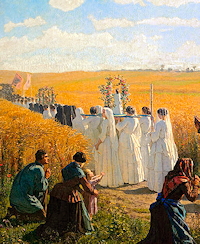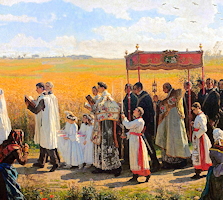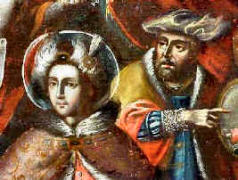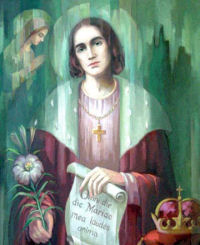Lent: March 4th
Saturday of the First Week of Lent; Optional Memorial of Saint Casimir; Ember Saturday of Lent
» Enjoy our Liturgical Seasons series of e-books!
Today is the feast of St. Casimir (1458-1484) who was born in 1458 and was the son of the King of Poland. At an early age he saw through the superficiality and corruption of court life. Throughout his short life—he died of consumption at the age of 26—he dedicated himself wholly to the service of God and of his fellow-men. His love for the poor was immense. He was also renowned for his devotion to the Eucharist and to the Blessed Virgin.
It is Ember Saturday of Lent or Spring Embertide. See Contemporary Observation of Ember Days and Lenten Ember Days for more information.
The traditional Station Church today is at St. Peter's Basilica. In this basilica at the Vatican priestly ordinations were formerly held on Ember Saturday (or early Sunday morning preceded by a long vigil). The 1962 Missal includes three extra Lessons, a relic of those read formerly during the night. The current Lectionary's first reading from Deuteronomy 26:16-19 is one of the readings from the former missal.
Meditation on the Liturgy—Spring Ember Days
 According to the tradition of the Church, the first week of Lent is the week of Spring Ember Days. Ember Days are specifically a tradition of the Church in Rome, its roots partly to be found in the Old Testament — where for example the prophet Zechariah attests four seasons of fasting in the years — and partly in the tradition of pagan Rome, with its festivals of seedtime and harvest still recalled in our own days. So we have this fine combination of creation and biblical history, a combination which is a sign of true catholicity. In the celebrations of these days we receive the year from the hand of God, receive our time from the Creator and Redeemers, and confide sowing and harvesting to his goodness, thanking him for the fruit of the earth and our work. The celebration of the Ember Days corresponds to the fact that "the creating waits with eager longing for the revealing of the sons of God" (Rom 8:19): through our prayer, creation enters into the Eucharist, has part in the praise of God.
According to the tradition of the Church, the first week of Lent is the week of Spring Ember Days. Ember Days are specifically a tradition of the Church in Rome, its roots partly to be found in the Old Testament — where for example the prophet Zechariah attests four seasons of fasting in the years — and partly in the tradition of pagan Rome, with its festivals of seedtime and harvest still recalled in our own days. So we have this fine combination of creation and biblical history, a combination which is a sign of true catholicity. In the celebrations of these days we receive the year from the hand of God, receive our time from the Creator and Redeemers, and confide sowing and harvesting to his goodness, thanking him for the fruit of the earth and our work. The celebration of the Ember Days corresponds to the fact that "the creating waits with eager longing for the revealing of the sons of God" (Rom 8:19): through our prayer, creation enters into the Eucharist, has part in the praise of God.
In the fifth century however, the Ember Days took on another dimension, becoming feasts of the spiritual harvest of the Church, feasts of Holy Orders. The arrangement of stational churches for these three days is very significant: Wednesday, Saint Mary Major; Friday, the Church of the Twelve Apostles; Saturday, St. Peter's. On the first day, the Church presented the ordinands to Our Lady, to the Church in person. "Sub tuum praesidium confugimus" (We fly to your protection), a Marian prayer of the third century, comes to mind here when we meditate on this action. The Church confides her ministers to the Mother: "Behold your mother". This word from the Cross encourages us to seek refuge close to our Mother. Under Our Lady's mantle, we are safe. In all our difficulties we can turn with immense faith to our Mother, we venture to take up our service.
 The Friday was the day of the Twelve Apostles' church. As "fellow-citizens of the saints and servants of God" we "are built upon the foundation of the apostles and prophets" (Eph 2:19-20). Only in the context of the apostolic succession, of the faith of the Apostles and of the apostolic structure of the Church, with a true priestly system, that is, can we construct the living temple of God. The ordinations themselves took place during the night of Saturday, with a view to Sunday morning in St. Peter's. Thus the Church expressed the unity of the priestly system in union with Peter, as Jesus at the beginning of his public life had called Peter and his "partners" (Lk 5:10), after he had been teaching from Simon's boat.
The Friday was the day of the Twelve Apostles' church. As "fellow-citizens of the saints and servants of God" we "are built upon the foundation of the apostles and prophets" (Eph 2:19-20). Only in the context of the apostolic succession, of the faith of the Apostles and of the apostolic structure of the Church, with a true priestly system, that is, can we construct the living temple of God. The ordinations themselves took place during the night of Saturday, with a view to Sunday morning in St. Peter's. Thus the Church expressed the unity of the priestly system in union with Peter, as Jesus at the beginning of his public life had called Peter and his "partners" (Lk 5:10), after he had been teaching from Simon's boat.
The first week of Lent is a week of seedtime: let us entrust to God's goodness the fruits of the earth and the work of human hands, so that all may receive daily bread, so that hunger may be taken from the earth. Let us entrust to God's goodness also the seed of the word, so as to revive in ourselves the gift of God which is in us "through the laying-on of the hands" of the bishop (2 Tim 1:6), in the apostolic succession, in union with Peter. Let us thank God who has protected us in all temptations and difficulties, and pray, in the words of the prayer after Communion, that God will extend to us his favor, that is, his eternal love, himself, the gift of the Holy Spirit, and that he will grant us also the temporal consolations that we need in our weakness:
"You have strengthened us Lord, through these mysteries and nourished us with your heavenly sacrament. Stay with us to comfort us and save us, and never cease to show us your favour".Let us make our prayer "through Christ our Lord". Let us pray as under our Mother's mantle. Let us pray as trustful children. The word of the Redeemer stands firm: "Have faith—I have overcome the world" (Jn 16:33).
—Cardinal Joseph Ratzinger (Pope Benedict XVI), Journey Towards Easter
Meditation—The Tree of Knowledge and the Cross
The sin that was wrought through the tree was undone by the obedience of the tree, obedience to God whereby the Son of man was nailed to the tree, destroying the knowledge of evil, and bringing in and conferring the knowledge of good; and evil is disobedience to God, as obedience to God is good. And therefore the Word says through Isaiah the prophet, foretelling what was to come to pass in the future—for it was because they told the future that they were "prophets"—the Word says through him as follows: I refuse not, and do not gainsay, my back have I delivered to blows and my cheeks to buffets, and I have not turned away my face from the contumely of them that spat. [Is. 50, 6] So by obedience, whereby He obeyed unto death, hanging on the tree, He undid the old disobedience wrought in the tree. And because He is Himself the Word of God Almighty, who in His invisible form pervades us universally in the whole world, and encompasses both its length and breadth and height and depth—for by God's Word everything is disposed and administered—the Son of God was also crucified in these, imprinted in the form of a cross on the universe; for He had necessarily, in becoming visible, to bring to light the universality of His cross, in order to show openly through His visible form that activity of His: that it is He who makes bright the height, that is, what is in heaven, and holds the deep, which is in the bowels of the earth, and stretches forth and extends the length from East to West, navigating also the Northern parts and the breadth of the South, and calling in all the dispersed from all sides to the knowledge of the Father.
—St. Irenaeus
Things to Do:
- Today's reading from the book of Isaiah declares that the fasting desired by the Lord is not so much denying oneself food (although this is important) but rather, consists in "Sharing your bread with the hungry, sheltering the oppressed and the homeless; / Clothing the naked when you see them, and not turning your back on your own." Many families take these words to heart by having an inexpensive, penitential dinner on Fridays in Lent (such as beans and rice) and then giving the extra money to the poor.
- Many families give each child one pretzel during Friday dinners in Lent. Remind your children of the spiritual significance of the pretzel.
- Pray the Stations of the Cross today with your family. An excellent version with beautiful meditations composed by our Holy Father is his Stations of the Cross at the Colosseum. Some other recommended versions are: Eucharistic Stations of the Cross, and the more traditional Stations of the Cross written by Saint Alphonsus Liguori can be found in most Catholic bookstores. Here are some guidelines for praying the Stations of the Cross in your home.
- Any of the linked activities (Fun Pretzel Project, Lenten Scrapbook, Candelabrum for Stations of the Cross) are a wonderful way for your children to spend their Friday afternoons throughout this season of Lent.
St. Casimir
St. Casimir, to whom the Poles gave the title of "The Peace-maker," was the third of the thirteen children of Casimir IV, King of Poland, and of Elizabeth of Austria, daughter of the Emperor Albert II. ...Devout from his infancy, the boy gave himself up to devotion and penance, and had a horror of anything approaching softness or self-indulgence. His bed was often the ground, and he was wont to spend a great part of the night in prayer and meditation, chiefly on the passion of our Saviour. His clothes were plain, and under them he wore a hairshirt. Living always in the presence of God, he was invariably serene and cheerful, and pleasant to all. The saint's love of God showed itself in his love of the poor who are Christ's members, and for the relief of these the young prince gave all he possessed, using in their behalf the influence he had with his father and with his brother Ladislaus when he became king of Bohemia. In honour of the Blessed Virgin Mary, Casimir frequently recited the long Latin hymn "Omni die dic Mariae," a copy of which was by his desire buried with him. This hymn, part of which is familiar to us through Bittleston's version, "Daily, daily sing to Mary," is not uncommonly called the Hymn of St. Casimir, but it was certainly not composed by him; it is three centuries older than his time.
 The nobles of Hungary, dissatisfied with their king, Matthias Corvinus, in 1471 begged the King of Poland to allow them to place his son Casimir on the throne. The saint, at that time not fifteen years old, was very unwilling to consent, but in obedience to his father he went to the frontier at the head of an army. There, hearing that Matthias had himself assembled a large body of troops, and finding that his own soldiers were deserting in large numbers because they could not get their pay, he decided upon the advice of his officers to return home. The knowledge that Pope Sixtus IV had sent an embassy to his father to deter him from the expedition made the young prince carry out his resolution with the firmer conviction that he was acting rightly. King Casimir, however, was greatly incensed at the failure of his ambitious projects and would not permit his son to return to Cracow, but relegated him to the castle of Dobzki. The young man obeyed and remained in confinement there for three months. Convinced of the injustice of the war upon which he had so nearly embarked, and determined to have no further part in these internecine conflicts which only facilitated the further progress into Europe of the Turks, St. Casimir could never again be persuaded to take up arms though urged to do so by his father and invited once more by the disaffected Hungarian magnates. He returned to his studies and his prayers, though for a time he was viceroy in Poland during an absence of his father. An attempt was made to induce him to marry a daughter of the Emperor Frederick III, but he refused to relax the celibacy he had imposed on himself.
The nobles of Hungary, dissatisfied with their king, Matthias Corvinus, in 1471 begged the King of Poland to allow them to place his son Casimir on the throne. The saint, at that time not fifteen years old, was very unwilling to consent, but in obedience to his father he went to the frontier at the head of an army. There, hearing that Matthias had himself assembled a large body of troops, and finding that his own soldiers were deserting in large numbers because they could not get their pay, he decided upon the advice of his officers to return home. The knowledge that Pope Sixtus IV had sent an embassy to his father to deter him from the expedition made the young prince carry out his resolution with the firmer conviction that he was acting rightly. King Casimir, however, was greatly incensed at the failure of his ambitious projects and would not permit his son to return to Cracow, but relegated him to the castle of Dobzki. The young man obeyed and remained in confinement there for three months. Convinced of the injustice of the war upon which he had so nearly embarked, and determined to have no further part in these internecine conflicts which only facilitated the further progress into Europe of the Turks, St. Casimir could never again be persuaded to take up arms though urged to do so by his father and invited once more by the disaffected Hungarian magnates. He returned to his studies and his prayers, though for a time he was viceroy in Poland during an absence of his father. An attempt was made to induce him to marry a daughter of the Emperor Frederick III, but he refused to relax the celibacy he had imposed on himself.
St. Casimir's austerities did nothing to help the lung trouble from which he suffered, and he died at the age of twenty-six in 1484 and was buried at Vilna, where his relics still rest in the church of St. Stanislaus. Miracles were reported at his tomb, and he was canonized in 1521.
—Excerpted from Butler's Lives of the Saints
Patronage: against plague; bachelors; kings; princes; single laymen; Lithuania (proclaimed by Pope Urban VIII in 1636); Lithuanian youth; Poland; diocese of Grodno, Belarus
Symbols and Representation: Lily (for purity); crown; grand ducal cap
Highlights and Things to Do:
- St. Casimir died at age 26 due to tuberculosis. Teach the young people in your family about this saint who was so ready to die at such a young age, that they may realize that sanctity is fully attainable regardless of their state in life.
- Read more about St. Casimir:
- Casimir's remains lie in Vilnius Cathedral in Lithuania in a silver sarcophagus.
- See Catholic Cuisine for some food ideas for St. Casimir's feast day.
- See Domestic Church for some ideas on how to celebrate this saint at home.
- Don't be a Catholic who doesn't know Scripture! In the Gospel today there is a good Scripture verse to memorize that will deepen your trust in your Heavenly Father: "If you, with all your sins, know how to give your children what is good, how much more will your heavenly Father give good things to anyone who asks him!" —Matt 7:11






